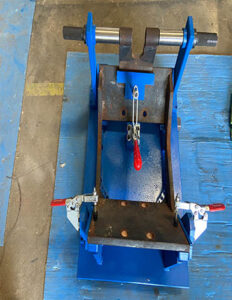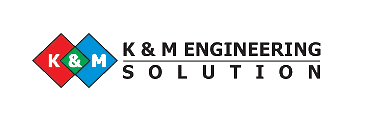In high-volume manufacturing, precision is not optional — it’s a baseline requirement. Yet many fabrication shops still struggle with alignment inconsistencies, relying heavily on operator skill, makeshift clamping, or outdated tooling. The result? Misaligned weldments, unpredictable tag placements, and an ever-growing pile of rework.
K& M Engineering Solution partnered with fabrication units across automotive, agricultural, and industrial sectors. Our purpose-built welding and tagging fixtures have helped eliminate alignment issues, reduce cycle times, and raise first-pass yield rates — not by pushing harder, but by designing smarter.
Let’s explore how these fixtures, when engineered for your specific parts and processes, become the silent backbone of repeatable quality.

The Real Cost of Alignment Errors
Misalignment in fabrication is a hidden productivity killer. You may not notice it in a single part, but over time, it multiplies into real business losses. Here are some typical consequences:
-
Weld gaps vary from part to part, leading to inconsistent strength
-
Tagging locations differ across batches, affecting traceability or compliance
-
Downstream assemblies suffer from poor fits, causing rejection or rework
-
Manual clamping introduces reliance on operator skill — and inconsistency
-
Heat distortion causes parts to twist or shift during welding
The longer these problems are tolerated, the more expensive they become — in man-hours, material waste, inspection effort, and customer trust.
What Welding and Tagging Fixtures Do Differently
Custom-built fixtures aren’t just about holding a part in place. They bring mechanical repeatability to complex fabrication processes. Here’s what makes them essential:
-
Dedicated Locators and Stops: Parts are placed the same way, every time, eliminating variation at the root
-
Strategic Clamping: Designed to hold parts without inducing stress or distortion, even during high-heat operations
-
Tagging Templates: Fixtures can include guides or slots to ensure that ID plates or engraved tags are always positioned correctly
-
Process Integration: Fixtures can be designed to support both manual and robotic welding operations seamlessly
-
Time Reduction: Faster setup, fewer adjustments, and quicker cycles — all critical in high-volume environments
In short, these fixtures make every part as precise as the first one.
A Real-World Example from the Shop Floor
One of our automotive clients was welding a multi-part frame structure — a mix of laser-cut MS plates and tubes. Their process relied on skilled welders to align and tack components by eye, using manual clamps. Misalignment led to 8% of parts being rejected at the assembly line, plus over 3 hours daily in rework.
We developed a welding and tagging fixture with precision locators, cam clamps, and an integrated tag-positioning bracket. The outcome:
-
Setup time reduced by 60%
-
Rejection rate dropped from 8% to below 1%
-
Weld consistency passed internal audits with zero deviation
-
Operator training time reduced from 3 days to 3 hours
The ROI was realized within just four weeks of implementation.
Comparison Table: With vs Without Fixtures
| Feature | Without Fixture | With Custom Fixture |
|---|---|---|
| Alignment Accuracy | Operator-dependent | Mechanically repeatable (±0.1 mm) |
| Tag Placement Consistency | Variable and manual | Fixed and repeatable via template |
| Weld Gap Uniformity | Inconsistent | Designed-in consistency |
| Heat Distortion Compensation | Not considered | Integrated into fixture design |
| Setup Time | Long, requires skilled labor | Short, even for semi-skilled operators |
| Scrap/Rework Rate | Moderate to high | Minimal to zero |
| Operator Skill Dependency | High | Low |
| Production Cycle Time | Longer | 25–40% faster on average |
Not all fixtures are created equal. A well-designed fixture is:
-
Built around the actual part geometry and welding process
-
Easy to load and unload, even in fast-paced environments
-
Designed with heat management in mind — accounting for weld distortion
-
Safe and ergonomic for operators to use
-
Flexible enough to allow minor part variations or upgrades
-
Constructed using robust materials (MS, tool steel, or treated aluminum)
In some cases, we also design dual-purpose fixtures that allow both welding and inspection to occur on the same base frame — especially useful in lean setups.
Tagging Matters More Than You Think
Many shops treat tagging as an afterthought. But inaccurate tag placement can lead to compliance issues, misidentification during assembly, or failures in traceability — especially for export or automotive OEM customers.
Our tagging fixtures are engineered with exact slot positions, ensuring tags (or engravings) are applied at the same angle, height, and surface — every single time. Whether it’s a riveted metal plate or laser-etched code, we design your fixture to make it foolproof.
Frequently Asked Questions
Q: Can the same fixture handle different product variants?
A: Yes. We often design modular fixtures with interchangeable locators and adjustable clamps. One base fixture can accommodate multiple SKUs, which is ideal for clients running variant assemblies.
Q: What if parts vary slightly batch-to-batch?
A: We account for tolerance windows and can design floating clamps or spring-loaded contacts that absorb minor variations without losing accuracy.
Q: Are your fixtures compatible with robotic welding arms?
A: Absolutely. We routinely design fixtures with robot access paths, clearance zones, and integration-ready bases for robotic welding and tagging systems.
Q: How long does it take to manufacture a custom welding fixture?
A: Typically 3–5 weeks from design finalization, depending on complexity. We also offer design + prototyping packages for critical components.
The Final Word: Consistency is Profit
In high-volume fabrication, variation is the enemy. No matter how good your welders or how advanced your machines, if the alignment of parts is inconsistent, your output will suffer. Welding and tagging fixtures remove that uncertainty.
They reduce setup time. They eliminate human error. They drive repeatable, documentable quality. And they pay for themselves many times over through scrap reduction and faster cycles.
We don’t sell generic tooling. We engineer application-specific fixtures based on your component, your line layout, your team, and your tolerances. Because at scale, every millimeter matters — and every minute saved is a competitive advantage.
- If you’re ready to eliminate guesswork from your welding process, our team is ready to help.

